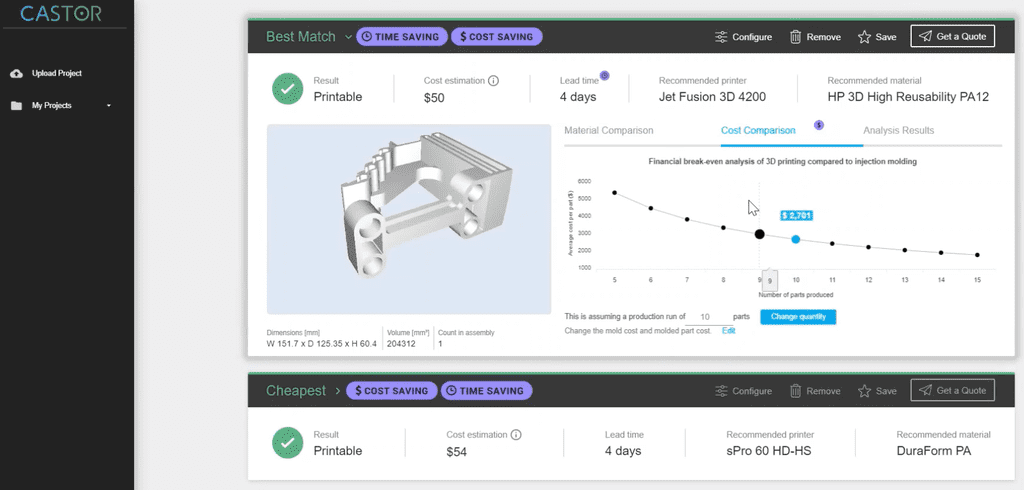Additive Manufacturing (AM, AKA 3D printing) exists for more than three decades, and over the last years AM technology tremendously matured and evolved. With that being said, most manufacturing companies are not benefiting from all the capacities of industrial 3D printing, and the adoption rates of AM for production use are much lower than those for prototyping and proof-of-concept purposes.
Most leading companies have already realized the potential of industrial 3D printing and wish to explore and utilize it, yet, it is still a challenge for most of them to identify if, where and in when to apply additive manufacturing while gainingprofit from using it. The main reason is a serious knowledge gap – Most companies don’t own enough in-house expertise to utilize 3D printing and are not sure whether the production via 3D printing will lead to cost-savings without harming important products’ properties. While shifting from traditional manufacturing to 3D printing will most likely result in added transitioning costs and will indeed change the mechanical properties of parts, it is important to realize that the cost-saving benefits opportunities that AM holds are in many cases greater than the compromises.
This is why it is so important to identify the right parts for 3D printing when you consider AM as a possible production option, and find the candidates that would make financial sense to print (i.e. lower production costs) and that geometry-wise, would be optimal for AM. By identifying the suitable parts for 3D printing, manufacturers can make sure that the materials, technology and economics all make sense. That way, they significantly reduce the risks associated with transitioning to additive manufacturing.
Understanding each part’s mechanical properties, geometry and financials, to decide whether it makes sense to 3D print parts, can be quite challenging. There are many decision factors to consider, mainly focusing on geometry, mechanical properties and economics.
Geometry-wise, even though AM is known for its capability to handle complex designs, there are still some important parameters affecting the printability of the part, due to limitations and geometry restrictions. The part’s size for instance, depends on each printer’s tray limitations. The minimum required wall thickness (i.e. the distance between one of the part’s surface to the opposite sheer surface) differs within technology and material. Another important decision parameter, which is not always calculated into conventional printability checks, is called the aspect ratio of the printer (i.e. the ratio between height, depth and thickness).
The mechanical requirements of each fabricated part are unique and consist of different levels of resistance, elasticity, density and so on. It is important to forecast how each material will react to forces that it is subjected to. For example, Tensile tests evaluate the Elongation property, which reflects how much strain a part can experience before failing under tensile load. A material analysis finds the most suitable material for each application and helps to evaluate the compromises that needs to be taken when deciding to 3D print any part. Every engineer must consider the price/time vs. the mechanical property, and decide how much compromise in mechanical property he is willing to accept to maximize cost reduction or lead time saving.
The financial considerations should compare 3D printing costs to traditional manufacturing costs. There is a specific financial break-even point between additive manufacturing to traditional methods. Generally speaking, some traditional methods are very low cost per-unit, but involve high initial investment, thus in total they aren’t cost effective for low volumes. Additive manufacturing, however, eliminates the initial investment costs and is ideal for cases like these (especially high-complex parts), since it lowers the cost per part significantly. Nonetheless, the cost estimations of both alternatives must be customized according to the expected volume of production, the cost estimation of raw materials, labour costs, and so on, in order to get to an accurate economic conclusion for each case.
Episode 2 – Selecting Parts For 3D Printing With Dr. Atanu Chaudhuri
Identifying parts for 3D printing takes into account all these considerations alongside other adjustable configurations according to the manufacturer’s preference. It provides a solid recommendation about each parts’ printability and easily highlights the opportunities for cost reduction. Manually, the process of screening thousands of parts will be very time-consuming and hard to perform without proper expertise. A software solution supporting the decision of the engineer, helps to make the screening process much more cost-and-time-effective.
The process of part identification is a critical step in the mission for cracking the challenges in transitioning to additive manufacturing. We can expect more and more companies over the next years to join the race for end-use plastics and end-use metals and to implement the part identification process in their organizations.
Omer Blaier is the CEO of CASTOR, a decision support software which conducts a technical and economic analysis, informs manufacturers when it is beneficial to use 3D printing instead of traditional manufacturing methods and provides feedback on each part. It recommends the suitable technology and material for the 3D printing, estimates the cost and lead-time for each part and connects the manufacturer to a service bureau that can print and supply the part according to the requirements. The easy-to-customize software recommendation, helps engineers to unlock the full benefits industrial 3D printing and helps them focus on the right parts that can improve their production and generate cost and lead time savings.



